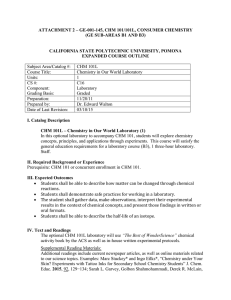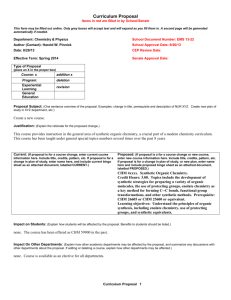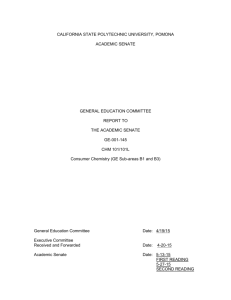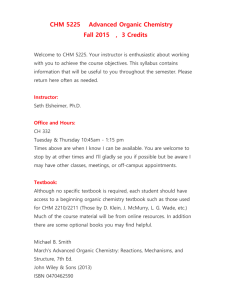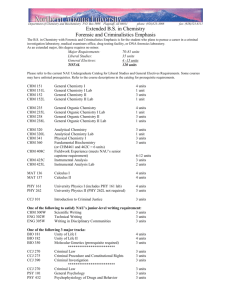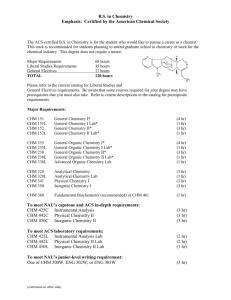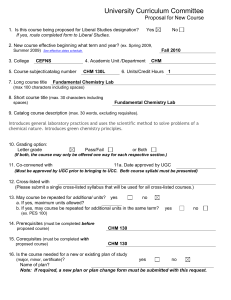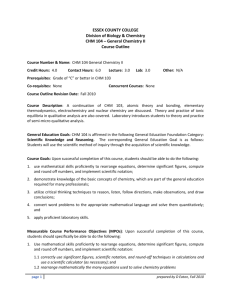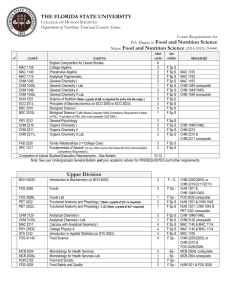Attachment 5 - GE-001-145, CHM 101/101L, Consumer Chemistry
advertisement
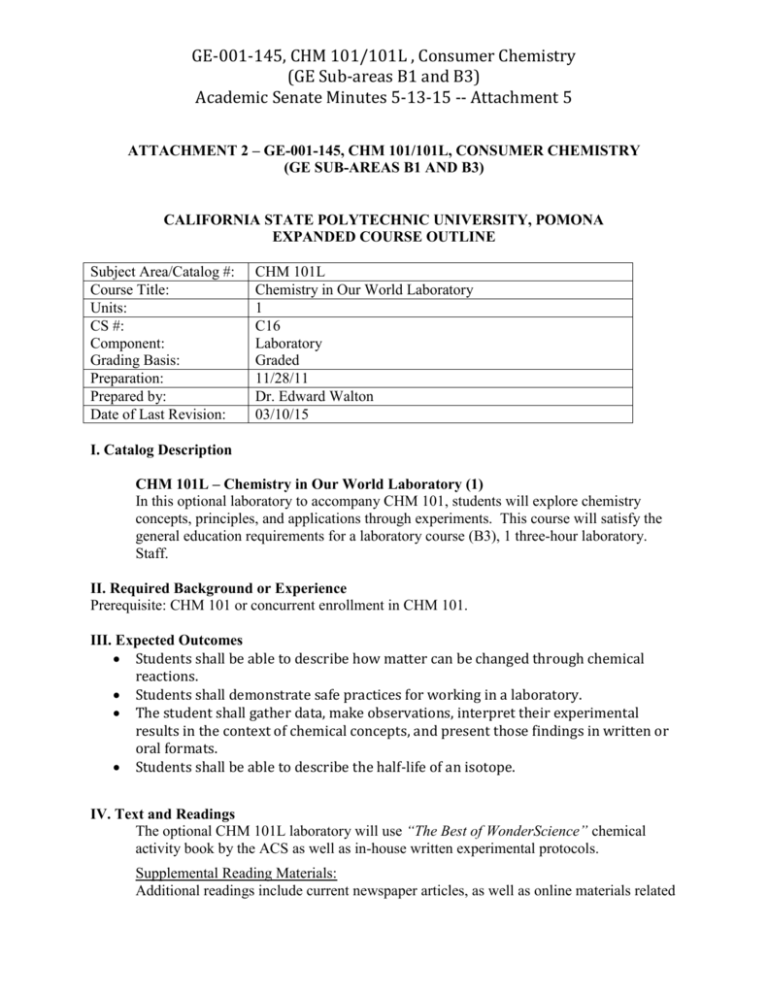
GE-001-145, CHM 101/101L , Consumer Chemistry (GE Sub-areas B1 and B3) Academic Senate Minutes 5-13-15 -- Attachment 5 ATTACHMENT 2 – GE-001-145, CHM 101/101L, CONSUMER CHEMISTRY (GE SUB-AREAS B1 AND B3) CALIFORNIA STATE POLYTECHNIC UNIVERSITY, POMONA EXPANDED COURSE OUTLINE Subject Area/Catalog #: Course Title: Units: CS #: Component: Grading Basis: Preparation: Prepared by: Date of Last Revision: CHM 101L Chemistry in Our World Laboratory 1 C16 Laboratory Graded 11/28/11 Dr. Edward Walton 03/10/15 I. Catalog Description CHM 101L – Chemistry in Our World Laboratory (1) In this optional laboratory to accompany CHM 101, students will explore chemistry concepts, principles, and applications through experiments. This course will satisfy the general education requirements for a laboratory course (B3), 1 three-hour laboratory. Staff. II. Required Background or Experience Prerequisite: CHM 101 or concurrent enrollment in CHM 101. III. Expected Outcomes Students shall be able to describe how matter can be changed through chemical reactions. Students shall demonstrate safe practices for working in a laboratory. The student shall gather data, make observations, interpret their experimental results in the context of chemical concepts, and present those findings in written or oral formats. Students shall be able to describe the half-life of an isotope. IV. Text and Readings The optional CHM 101L laboratory will use “The Best of WonderScience” chemical activity book by the ACS as well as in-house written experimental protocols. Supplemental Reading Materials: Additional readings include current newspaper articles, as well as online materials related GE-001-145, CHM 101/101L , Consumer Chemistry (GE Sub-areas B1 and B3) Academic Senate Minutes 5-13-15 -- Attachment 5 to our science topics. Examples: Marc Stuckey* and Ingo Eilks*, “Chemistry under Your Skin? Experiments with Tattoo Inks for Secondary School Chemistry Students” J. Chem. Educ. 2015, 92, 129−134; Sarah L. Garvey, Golbon Shahmohammadi, Derek R. McLain, and Mark L. Dietz*, Determination of Calcium in Dietary Supplements: Statistical Comparison of Methods in the Analytical Laboratory, J. Chem. Educ. 2015, 92, 167−169. Laboratory experimental instructions shall be made available on Blackboard. V. Minimum Student Material Access to a computer, printer and the Internet, ANSI approved safety goggles and a lab coat, and an American Chemical Society’s science experiments book. Product fee may apply. VI. Minimum College Facilities CHM 101L will require a chemistry laboratory with seating up to 24, equipped with basic laboratory furniture (lab benches) and equipment (balances, fume hood, eyewash, safety shower). VII. Course Outline Week # Major Topics 1 Introduction 2 Matter 3 Gases and Air 4 Water 5 Energy 6 Nuclear Chemistry 7 Acids and Bases 8 Polymer Chemistry CHM 101L (Optional) Introduction to Safety, waste disposal, and laboratory notebook use Golden Penny (elements, compounds, and mixtures): Pennies are cleaned and examined, coated with a layer of zinc, then heated to create an alloy (brass). Making Gases (O2, CO2 and NO2): Gases are formed and captured during chemical reactions and their properties examined. Water’s polarity is explored via mixing with other chemicals that are polar, ionic and non-polar. Water samples containing ions are analyzed. Chemical Energy (combustion of Bio-mass): The energy content of a variety of foods will be examined via calorimetry and then compared to see which foods contain the most energy. Half Life Simulation: Rates of nuclear decay will be explored during this simulation. Students will investigate and write a report about the medicinal use of a radioisotope. Titration of Antacids: Different commercial antacids will be titrated to determine their effectiveness as antacids. Natural pH Indicators will be prepared and then used during the titrations. A variety of polymers will be synthesized and their chemical and physical properties compared. GE-001-145, CHM 101/101L , Consumer Chemistry (GE Sub-areas B1 and B3) Academic Senate Minutes 5-13-15 -- Attachment 5 9-10 Biochemistry Food Testing for Carbohydrates, Lipids, and Proteins. A variety of chemical methods will be used to test for the presence of each type of biological polymer and various types of foods will be examined for polymer presence. Check-out and Review VIII. Instructional Methods The instructional methods used in this course will include active and collaborative learning in a laboratory setting. Students will collect, present, and interpret data via reports and presentations. Class discussions will enhance the exposure to information, ideas, and issues. IX. Evaluation of Outcomes Students will receive feedback on their reports and any presentations from the instructor and from other students. At least one laboratory report will be peer and instructor reviewed prior to revision and resubmission. X. Relationship to Program Objectives The CHM 101L course will allow students to meet some of the measureable goals and outcomes for the GE program at Cal Poly Pomona. Specifically, this course is designed to meet the requirements for a B3, laboratory activity. GE Outcomes B3 Courses shall minimally meet GE Outcomes Ic, Id, and IIa CHM 101L Goal I (Acquire foundational skills and capacities), item c: (Construct arguments based on sound evidence and reasoning to support an opinion or conclusion). Goal I (Acquire foundational skills and capacities), item d (Apply and communicate quantitative arguments using tables, graphs, and equations as appropriate). Goal II (Develop an understanding of various branches of knowledge and their interrelationships), item a (Apply scientific methods and models to draw quantitative and Analyze data from experiments, synthesize conclusions, test hypotheses. Communicate results in written laboratory reports or presentations. Analyze peers arguments and conclusions. Organize and present data gathered in both tabular and graphical formats. Use these to communicate and support conclusions in written lab reports. From examination of laboratory data collected, as well as analysis of others’ data and findings, use GE-001-145, CHM 101/101L , Consumer Chemistry (GE Sub-areas B1 and B3) Academic Senate Minutes 5-13-15 -- Attachment 5 qualitative conclusions about the physical and natural world). Assignment Alignment with GE Student Learning Outcomes Laboratory Reports Class Discussions Paper Peer Review of Paper scientific method to draw qualitative and quantitative conclusions and relate to chemical knowledge in the world. Ic Id IIa Written Communication x x x x x x x x x x x x x x Oral Communication x
